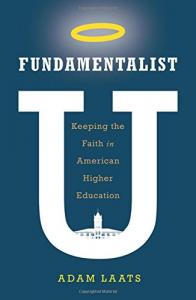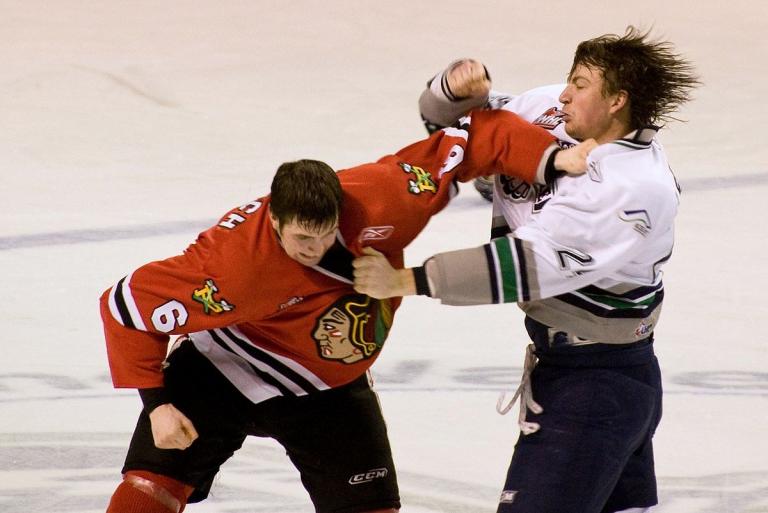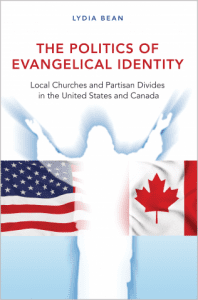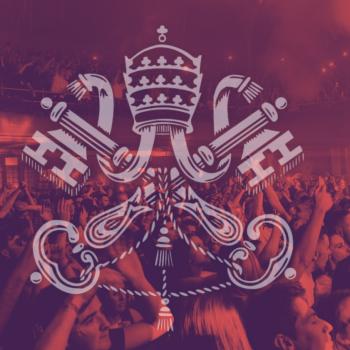Last night the Boston Bruins took the first game of the 2019 Stanley Cup finals over the visiting St. Louis Blues. Seeking their 7th championship, the Bruins scored four unanswered goals after giving up two early ones to the Blues, back in the finals for the first time since losing to Boston in 1970. But thanks to historian Adam Laats, all I can think about when I watch NHL highlights is the future of evangelicalism.
 The author of Fundamentalist U, Adam is one of my favorite non-evangelical observers of evangelicalism. If you work for a university like mine, Adam’s blog should be required reading: he’s a perceptive, critical, and empathetic historian of evangelical higher education and evangelicalism more broadly. In a recent post, he suggested an analogy to help explain what he sees as the fundamental weakness of “politically liberal white evangelicalism”:
The author of Fundamentalist U, Adam is one of my favorite non-evangelical observers of evangelicalism. If you work for a university like mine, Adam’s blog should be required reading: he’s a perceptive, critical, and empathetic historian of evangelical higher education and evangelicalism more broadly. In a recent post, he suggested an analogy to help explain what he sees as the fundamental weakness of “politically liberal white evangelicalism”:
The evangelical left is in a similar position to hockey purists who want to ban fighting.
Think about it: In many ways, the anti-fighting faction has a strong case. They argue that the sport is being hurt by the constant fighting, that brutish “enforcers” are kept on team rosters just to intimidate the opposition. The anti-fight faction can point to decades of expert opinion on their side, including a strong 1988 anti-fight statement from the Canadian Academy of Sport and Exercise Medicine. The constant fights, experts agree, are killing the game of hockey. At the college and youth levels, fighting has significantly decreased.
Yet fighting retains its revered unofficial status in the NHL.
Now, Adam doesn’t exactly explain what he sees as the evangelical analogue of hockey fights that progressives would like to eliminate. But I took him to mean social and political conservatives’ culture-warring with people outside of evangelicalism. Though I thought also of their propensity for hunting heretics within their own movement or other Christian traditions.
I’m more of a political moderate than a liberal, but as an evangelical, I do lament both kinds of “fighting.” I wish that the “enforcers” who engage in it wouldn’t so often define evangelicalism in this country. Maybe it’s just that I’ve been hanging around the faculty lounge too much, but I think that people of the Evangel can proclaim the Gospel without making the Good News sound like such bad news.
I think Adam would warn me that, like the NHL’s anti-fighting activists, evangelicals like me “have a very easy door out, but a very difficult, slippery, obstacle-filled uphill climb to change things.” Just as “many hockey fans have no idea that one could separate fighting from hockey,” I take him to mean that most evangelicals can’t abide the idea of a less combative, more irenic evangelicalism.
Like most analogies, Adam’s helps us to see something familiar in new ways… but it also starts to break down the further you push it. Forgive this blog’s only Minnesotan for getting into the weeds of his state’s favorite sport, but I want to point out two problems with Adam’s analogy and why it might then have other implications for evangelicalism.

First, the NHL is an anomaly in hockey.
Apart from pro hockey in North America, the sport almost never features fighting, whether in American high schools and colleges, European leagues, or international competitions like the Olympics. “If there are fans who enjoy fighting they should turn to other sports,” said the president of the International Ice Hockey Federation in 2007, “we simply cannot tolerate Neanderthal behaviour.”
Why the difference? It starts with differences in hockey’s rule books. In the NHL and its associated minor and junior leagues, fights do carry a major penalty of five minutes, but that has almost no impact on the game. In most cases, there’s no power play advantage, since both teams lose a player — and it’s usually a relatively unskilled one who plays few shifts anyway. But at all other levels, fighting carries much stiffer penalties: players are thrown out of that game and face suspensions from future games. Just like what happens when players fight in all other major team sports, even in North America.
(And this hasn’t always been true. I think the history of the National Basketball Association is particularly instructive. Fighting was never quite as central to pro basketball as it has been to pro hockey, but brawls were hardly uncommon in the NBA, and the league had its own long tradition of “enforcers” until rule changes and suspensions made such players obsolete.)
Does that mean anything for the future of evangelicalism? It doesn’t seem like a religious movement that lacks any governing authority could have its behavior modified by the equivalent of “rules changes.” There’s no magisterium, ecumenical council, or general assembly to tell evangelicals to stop needlessly fighting each other and everyone else — or to penalize them when they break that rule.
And absent such regulation and disincentives, is there any reason to think that evangelicalism would become any less combative? Well, here let me point out that “fighting” is not typical of evangelicalism in at least some other parts of the world… like Canada, eh?
 My neighbors to the north may love fighting in hockey, but their evangelicals behave very differently than ours. Here I’d recommend Lydia Bean’s comparative study of evangelical congregations along the New York-Ontario border; while the Canadians were about as theologically and socially conservative as their neighbors, they were far less politically partisan. She found that Canadian evangelicals weren’t Religious Right stalwarts, but instead exemplified what Christian Smith has called “engaged orthodoxy”: “sustaining a dynamic tension with their sociocultural environment, while avoiding separatism.”
My neighbors to the north may love fighting in hockey, but their evangelicals behave very differently than ours. Here I’d recommend Lydia Bean’s comparative study of evangelical congregations along the New York-Ontario border; while the Canadians were about as theologically and socially conservative as their neighbors, they were far less politically partisan. She found that Canadian evangelicals weren’t Religious Right stalwarts, but instead exemplified what Christian Smith has called “engaged orthodoxy”: “sustaining a dynamic tension with their sociocultural environment, while avoiding separatism.”
Maybe that’s just a function of Canada’s evangelicals being an even smaller minority in a more secular country. (Perhaps it does result from “rules changes” imposed from above — not by religious authorities, but those wielding political, legal, educational, economic, and cultural power.) In any event, the case of Canada does suggest that evangelicalism can become less combative while still remaining recognizably evangelical. And that leads me to the most important problem with Adam’s analogy:
Fighting is disappearing from the NHL.
According to HockeyFights.com (yes, that’s a thing), less than 17% of NHL games this season have had even one fight, down from 25% just two years ago and 40% ten years ago. So far in the 2019 Stanley Cup playoffs, there have been only three fights (vs. eight last year), and none since mid-April. And a recent Charleston Post and Courier article points out that the decline in fighting has deep roots: down 80% in the last two seasons of the Ontario Hockey League, one of the main developmental systems for the NHL, with a similar drop in the highest minor league, the American Hockey League.
To some extent, this does reflect some subtle rule changes. Since the 1990s, the NHL has added an additional penalty for players who “instigate” fights. And as a couple of my hockey-playing students pointed out this spring on an episode of our sports history podcast, the NHL now prohibits players from removing helmets before a fight, which means that pugilists risk doing serious damage to their hands. (It used to be an unwritten rule that you couldn’t fight unless you took off your helmet.)
But most analysts point to a more fundamental shift: the way the NHL game is played has itself evolved.
As ESPN writer Greg Wyshynski told the story last January, the change goes back to 2005. In the wake of a full-season lockout that seriously damaged fan interest in the game, the NHL modified rules to promote higher scoring. (It’s working: average game attendance was up by a thousand ten years after the lockout.) Fights didn’t start to fall off significantly for several years, but in the meantime, it became more and more important that teams not waste roster spots on relatively slow players with limited skating, puck-handling, passing, and scoring abilities. “We saw some pretty stark changes,” retired enforcer Stu Grimson told ESPN, “and it’s taken a while for those changes to completely permeate. The game’s gotten faster. At the end of the day, there’s a little less room for a player that’s predominately [sic] a physical player. Roster space is precious. You need guys that bring three, four tools.”
A few diehards notwithstanding, few serious NHL fans think that the decline in fighting means that the league is no longer playing true hockey. So again, I have to wonder: could evangelicalism evolve past its own equivalents to “dropping the gloves”? Could evangelicals change the way they “play the game” in response to declining “fan interest”?
Like I said, analogies break down faster the further you push them, so all I can do at this point is speculate. But given evangelicalism’s long history of adaptation to cultural, economic, and demographic change, it’s not hard to imagine more and more evangelical innovators consciously pulling back from tactics that would have been commonplace in previous generations, should they see more of their children leave their churches and fewer converts fill the pews. It might take a generation to see the results, but I already notice evangelical congregations and denominations, parachurch ministries, media and publishers, colleges and seminaries, etc. starting to make less room in leadership “for a player that’s predominately [sic] a physical player” and instead cultivating leaders with skills that are more helpful in an increasingly post-Christian, hopefully post-Trump, and inevitably majority-minority society.













